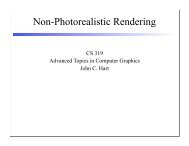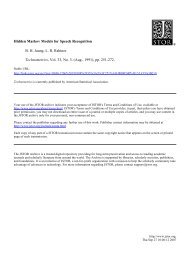On the Form Factor between Two Polygons
On the Form Factor between Two Polygons
On the Form Factor between Two Polygons
You also want an ePaper? Increase the reach of your titles
YUMPU automatically turns print PDFs into web optimized ePapers that Google loves.
L(b)(y) := <br />
y 2 2 −3 1 −b ln(y−1)<br />
t (1 − t ) ln(b + t) dt = 16 (b+1) 2<br />
b ln(1+y)<br />
− (b−1) 2 <br />
2(b+y)(1+by)[(b−y)<br />
2<br />
+(by−1)<br />
2<br />
]<br />
+ (b2−1) 2 (y2−1) 2<br />
M(y) := y t 2 (1 − t 2 ) −3 dt = 1<br />
16<br />
G(q)(y) := y ln q(t) dt = q ′ (y)<br />
2a<br />
H(q)(y) := y t ln q(t) dt =<br />
+<br />
2(b−y)<br />
(b2−1)(y2−1) y 2<br />
+ Li2<br />
1−y<br />
1+b<br />
− Li2<br />
1+y<br />
1−b<br />
<br />
4y(y 2 − 1) −2 + 2y(y 2 − 1) −1 + ln y−1<br />
y+1<br />
2<br />
d<br />
ln q(y) − 2y + a tan−1 q′ (y)<br />
d<br />
c b2<br />
+ − 2a 4a2 <br />
ln q(y) − y(ay−b)<br />
2a<br />
<br />
bd<br />
−<br />
2a2 tan −1 q′ (y)<br />
d<br />
+ ln (1−y)(1−b)<br />
<br />
(1+y)(1+b) ln(b + y)<br />
Table 1: Four auxiliary integrals needed in <strong>the</strong> solution. Notice that L(b)(y) uses <strong>the</strong> dilogarithm [1], Li2(z) = ∞<br />
1<br />
− ln(1−z)<br />
z . In G and H <strong>the</strong> argument q is an arbitrary quadratic polynomial q(t) = at 2 + bt + c and d = √ 4ac − b2 .<br />
c0 = Ej<br />
c1 = −2 di · dj<br />
c2 = Ei<br />
c3 = −2dj · (pi − pj)<br />
c4 = 2 di · (pi − pj)<br />
c5 = pi − pj 2<br />
c10 = 4 − c 2 1<br />
c11 = 4c4 − 2c1c3<br />
c12 = 4c5 − c 2 3<br />
c13 = c <br />
11− c2 11 −4c10c12 2c10 <br />
c2 11<br />
c14 =<br />
−4c10c12<br />
c10 c15 = √ c10c14<br />
c16(s) = c1c13 − c3 − 2s<br />
c17(s) = −c <br />
15+ c2 15 −4|c16(s)| 2<br />
2i ¯c16(s)<br />
c18(s) = −c <br />
15− c2 15 −4|c16(s)| 2<br />
2i ¯c16(s)<br />
Table 2: All expressions for two edges Eij with parameterization<br />
xi(t) = pi + t di and xj(s) = pj + s dj ( di,j = 1).<br />
implementation requires some care because of <strong>the</strong> complexities of<br />
<strong>the</strong> functions that are involved.<br />
A simple example, which requires <strong>the</strong> full power of our formula,<br />
concerns <strong>the</strong> form factor <strong>between</strong> two equal width rectangles<br />
sharing an edge with an enclosing angle θ ∈ [0, π]. The configuration<br />
is illustrated in Figure 1 toge<strong>the</strong>r with <strong>the</strong> form factor as<br />
a function of θ for different aspect ratios l = a<br />
(common edge<br />
b<br />
length b).<br />
4 Conclusion<br />
We have given a closed form solution for <strong>the</strong> form factor <strong>between</strong><br />
two general polygons. This solution is non-elementary since it<br />
1.<br />
F<br />
12<br />
0.8<br />
0.6<br />
0.4<br />
0.2<br />
10 20 30 40 50 60 70 80 90 100 110 120 130 140 150 160 170 180 θ<br />
Z<br />
a<br />
Y<br />
θ b<br />
Figure 1: Geometry for two rectangles sharing a common edge<br />
with an enclosing angle of θ. The graphs show <strong>the</strong> form factor as<br />
of .2, .4, .6, .8, and 1.0.<br />
a function of θ for edge ratios l = a<br />
b<br />
X<br />
164<br />
z k<br />
k2 , d<br />
Li2(z) =<br />
dz<br />
involves <strong>the</strong> dilogarithm function. The principal value of our<br />
solution is in determining exact answers for general polygonal<br />
configurations. This can be used in practice for reference solutions<br />
to check more efficient approximations. Baum et al. [2] have also<br />
shown that <strong>the</strong> error in <strong>the</strong> computed solution can be reduced<br />
significantly when using a closed form solution near singularities<br />
of <strong>the</strong> integrand.<br />
There has been a long history of computing closed form expressions<br />
for form factors starting with Lambert in 1760. The<br />
literature lists many special cases for which closed form solutions<br />
exist, but hi<strong>the</strong>rto no solution had been given for general<br />
polygonal configurations. The present paper closes this gap.<br />
Acknowledgements<br />
The first author would like to thank <strong>the</strong> Sci-Vis group at HLRZ for<br />
<strong>the</strong>ir support. O<strong>the</strong>r support came from Apple, Silicon Graphics<br />
and <strong>the</strong> NSF (contract no. CCR 9207966).<br />
References<br />
[1] Abramowitz, M., and Stegun, I. A. Handbook of Ma<strong>the</strong>matical<br />
Functions, 9th ed. Dover Publications, 1970.<br />
[2] Baum, D. R., Rushmeier, H. E., and Winget, J. M. Improving<br />
Radiosity Solutions Through <strong>the</strong> Use of Analytically Determined<br />
<strong>Form</strong>-<strong>Factor</strong>s. Computer Graphics 23, 3 (July 1989), 325–<br />
334.<br />
[3] Cohen, M. F., and Greenberg, D. P. The Hemi-Cube: A<br />
Radiosity Solution for Complex Environments. Computer Graphics<br />
19, 3 (July 1985), 31–40.<br />
[4] Goral, C. M., Torrance, K. E., Greenberg, D. P., and<br />
Battaile, B. Modelling <strong>the</strong> Interaction of Light <strong>between</strong> Diffuse<br />
Surfaces. Computer Graphics 18, 3 (July 1984), 212–222.<br />
[5] Hanrahan, P., Salzman, D., and Aupperle, L. A Rapid<br />
Hierarchical Radiosity Algorithm. Computer Graphics 25, 4 (July<br />
1991), 197–206.<br />
[6] Herman, R. A. A Treatise on Geometrical Optics. Cambridge<br />
University Press, 1900.<br />
[7] Lambert. Photometria sive de mensura et gradibus luminis, colorum<br />
et umbrae. 1760. German translation by E. Anding in Ostwald’s<br />
Klassiker der Exakten Wissenschaften, Vol. 31-33, Leipzig, 1892.<br />
[8] Nishita, T., and Nakamae, E. Continuous Tone Representation<br />
of Three-Dimensional Objects Taking Account of Shadows and<br />
Interreflection. Computer Graphics 19, 3 (July 1985), 23–30.<br />
[9] Schröder, P., and Hanrahan, P. A Closed <strong>Form</strong> Expression<br />
for <strong>the</strong> <strong>Form</strong> <strong>Factor</strong> <strong>between</strong> <strong>Two</strong> <strong>Polygons</strong>. Tech. Rep. CS-404-<br />
93, Department of Computer Science, Princeton University, January<br />
1993.<br />
[10] Wallace, J. R., Elmquist, K. A., and Haines, E. A. A Ray<br />
Tracing Algorithm for Progressive Radiosity. Computer Graphics 23,<br />
3 (July 1989), 315–324.<br />
[11] Wolfram, S. Ma<strong>the</strong>matica. Addison-Wesley, 1988.




